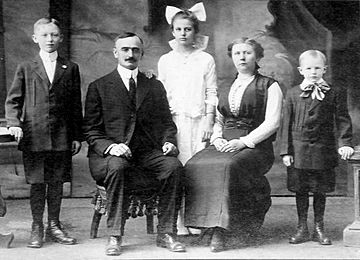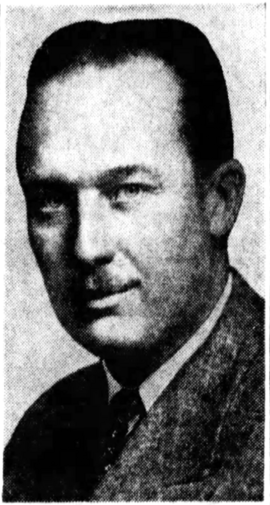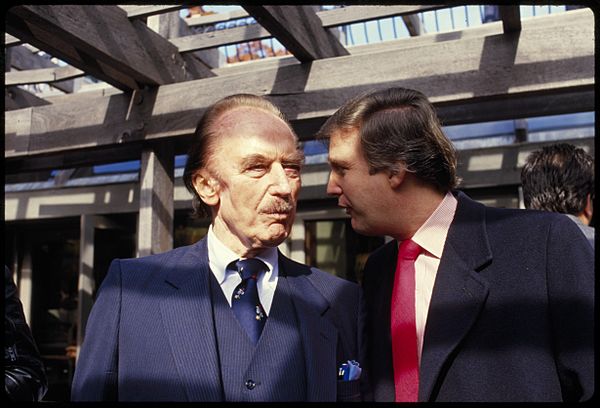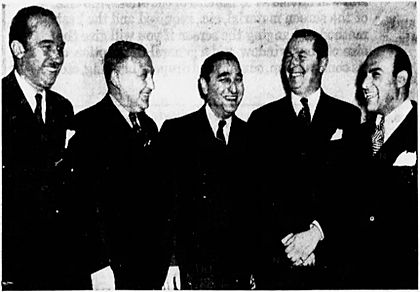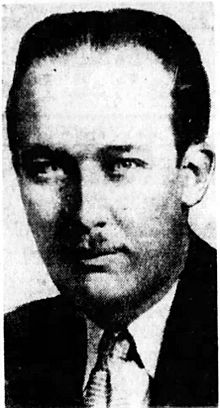Fred Trump facts for kids
Quick facts for kids
Fred Trump
|
|
|---|---|
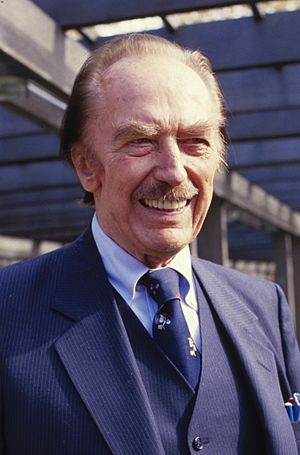
Trump in the mid-1980s
|
|
| Born |
Frederick Christ Trump
October 11, 1905 New York City, U.S.
|
| Died | June 25, 1999 (aged 93) New Hyde Park, New York, U.S.
|
| Burial place | Lutheran All Faiths Cemetery, New York City |
| Education | Pratt Institute Richmond Hill High School |
| Occupation | Head of Fred Trump Organization |
| Spouse(s) | |
| Children | |
| Parent(s) | Frederick Trump Elizabeth Christ Trump |
| Relatives | See Trump family |
| Awards | Horatio Alger Award |
Fred Trump Sr. (born October 11, 1905 – died June 25, 1999) was an American businessman. He was a successful real estate developer. Fred was also the father of Donald Trump, who became the 45th president of the United States.
Fred started his career in building and selling homes with his mother, Elizabeth Christ Trump. Their company was called E. Trump & Son. Later, it became the Fred Trump Organization. The company built many homes and apartments in New York City. This included more than 27,000 apartments.
Fred Trump faced some investigations during his career. In 1973, his company was sued by the U.S. Justice Department. This was because of issues with racial discrimination in renting apartments. The company was ordered to take steps to stop such discrimination.
For many years after World War II, Fred Trump did not talk about his German background. Instead, he said he was from Sweden. This was to avoid being linked to Nazism after the Holocaust. He also supported Jewish causes.
Contents
Fred Trump's Early Life and Career
Fred Trump's father, Frederick Trump, was German American. He earned a lot of money during the Klondike Gold Rush. He ran a restaurant for miners. Frederick returned to Germany in 1901. There, he met and married Elizabeth Christ Trump. They moved to New York City. Their first child, Elizabeth, was born in 1904.
The family went back to Germany. Fred was born in Germany on October 11, 1905. However, his father was told to leave Germany. So, the family returned to New York. They moved to the Bronx. Fred's younger brother, John G. Trump, was born in 1907. All three children grew up speaking German. In 1908, the family moved to Woodhaven, Queens.
Fred's childhood stories often highlight his hard work. At age 10, he delivered meat for a butcher. When he was about 12, his father died during the 1918 flu pandemic. From 1918 to 1923, Fred went to Richmond Hill High School. He worked many jobs, like a caddy and a newspaper hawker. His mother continued the real estate business his father had started.
Fred wanted to be a builder. He built a garage for a neighbor. He also took night classes in carpentry and reading blueprints. He learned about plumbing, masonry, and electrical wiring through mail courses.
After finishing high school in 1923, Fred worked full-time. He moved lumber to construction sites. His mother loaned him $800 to build his first house. He finished and sold it in 1924. By 1926, Fred had built 20 homes in Queens. He sold some before they were done to pay for others. His mother held the business in her name. This was because Fred was not yet an adult. The company was officially formed in 1927.
An Arrest in 1927
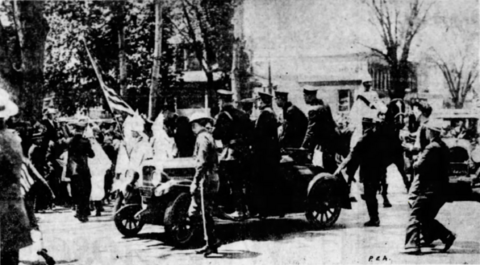
On Memorial Day in 1927, a parade took place in Queens. Over a thousand members of the Ku Klux Klan (KKK) marched. They were protesting against "Native-born Protestant Americans". They felt these Americans were being "assaulted by Roman Catholic police".
Fred Trump, who was 21, and six other men were arrested. Newspapers called them "berobed marchers". Trump was arrested for "refusing to disperse from a parade". His case was later dismissed. Other men arrested were confirmed to be Klan members. Fred's address at the time was in Jamaica, Queens. This address was listed in newspaper articles. Despite this arrest, there is no proof that Fred Trump was a member or supporter of the KKK.
Building Success
In 1933, Fred Trump built one of New York City's first modern supermarkets. It was called Trump Market in Woodhaven, Queens. It was like Long Island's King Kullen, a self-service store. Trump's store advertised "Serve Yourself and Save!" and became very popular. After six months, he sold it to King Kullen.
In 1934, Trump and a partner bought a company that managed mortgages. This company had gone bankrupt. This allowed Trump to get ownership of many properties. These properties were close to being taken by banks. He bought them cheaply and sold them for a profit. This helped him become a successful businessman in New York City.
Trump used government loans from the Federal Housing Administration (FHA). This program was started by President Franklin D. Roosevelt in 1934. By 1936, Trump had 400 workers building houses. These houses sold for $3,000 to $6,250. He used a trick from his father. He listed properties at prices like $3,999.99.
In the late 1930s, he advertised his business using a yacht. It was called the Trump Show Boat. It played patriotic music. It also floated swordfish-shaped balloons. These could be traded for money off a property. In 1938, the Brooklyn Daily Eagle called Trump the "Henry Ford of the home building industry".
Later Career and Projects
During World War II, Trump built housing for U.S. Navy workers. These were near shipyards on the East Coast. After the war, he built housing for families of returning soldiers. From 1947 to 1949, Trump built Shore Haven in Bensonhurst, Brooklyn. This project had 32 buildings and a shopping center. It received $9 million in FHA funding.
In 1950, he built Beach Haven Apartments near Coney Island. This project had 23 buildings and received $16 million in FHA funds. These projects together included over 2,700 apartments.
In 1961, Trump gave money to New York mayor Robert F. Wagner Jr.'s re-election campaign. This helped him get approval for Trump Village. This was a large apartment complex in Coney Island. It was built in 1963–64 for $70 million. It was one of Trump's biggest projects. It was also the only one named after him. He built over 27,000 low-income apartments and row houses in the New York area.
Investigations and Challenges
In 1954, Fred Trump was investigated by a U.S. Senate committee. They looked into how builders made profits from government contracts. Trump and his partner were examples of this. They had paid $34,200 for land. They then rented it to their company for $76,960 each year. This meant if the apartment building failed, the FHA would owe them a lot of money. Trump argued that he had not taken the money out. He also said that rising costs would have caused him to lose money otherwise.
In 1966, Trump was investigated again. This time it was by New York's State Investigation Commission. Trump had estimated building costs too high for a state program. He made $598,000 from equipment rentals for Trump Village. This money was then used for other projects. Trump said he did nothing wrong. The commission called him "a pretty shrewd character". They said he had a "talent for getting every ounce of profit". But no charges were made. Instead, the state housing program was told to have stricter rules.
Steeplechase Park
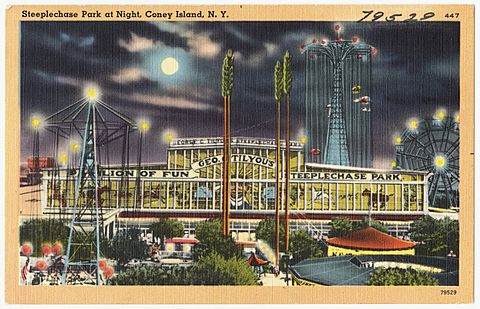
On July 1, 1965, Trump bought Steeplechase Park in Coney Island for $2.3 million. He planned to build luxury apartments there. In 1966, he announced plans for a large dome with fun facilities. In September 1966, Trump tore down the park's Pavilion of Fun. This was a large amusement center. He even sold bricks to guests to smash the glass panels. These panels included the park's famous "Funny Face" mascot.
The next month, New York City wanted to buy the land for public use. Trump went to court many times about this. He eventually won $1.3 million. The site was empty for several years. Then, Trump rented it out for fairground rides. After another ten years, the city finally got the property back.
Donald Joins the Business
Fred's son, Donald, joined his father's real estate business around 1968. He started working in Brooklyn. By 1971, he became the company president. Around 1973, Donald started calling the company the Trump Organization. Donald focused on real estate in Manhattan. His father mostly stayed in Brooklyn, Queens, and Staten Island. Donald later said this was good for him. He got Manhattan "all to myself."
Many people say Fred himself wanted the family business to expand to Manhattan. According to Mary L. Trump, Fred was "deeply involved" in Donald's early projects in Manhattan. He helped with financing these developments. In the mid-1970s, Donald received loans from his father. These loans were more than $14 million.
In 2015–16, during his campaign for U.S. president, Donald said his father gave him "a small loan of a million dollars." He said he used it to build a company worth over $10 billion. However, a 2018 New York Times report looked at Fred and Donald Trump's money. It found that Donald was a millionaire by age 8. It also said he received over $413 million (adjusted for inflation) from Fred's business over his life. This included over $60.7 million in loans, which were mostly not paid back.
Lawsuit About Fair Housing
In 1972, some people from minority groups said they were not allowed to rent apartments from Trump. They complained to the New York City Commission on Human Rights. These groups sent people to test Trump's buildings. They found that white people were offered apartments. But black people were often told there were no empty apartments. A building manager said this was what his boss told him to do.
The groups then told the Justice Department. In October 1973, the Justice Department sued the Trump Organization. They said the company was breaking the Fair Housing Act of 1968. Fred Trump was the chairman, and Donald Trump was the president. The Trump family's lawyer, Roy Cohn, sued back. He said the Justice Department was making false accusations.
The Federal Bureau of Investigation (FBI) talked to many former Trump employees. Some said they did not know about any unfair practices. Others said a small number of apartments were rented to black or Puerto Ricans people. One former doorman said his boss told him to tell black people the rent was double the real price. Four landlords or rental agents said that applications sent to the Trump office were marked by the applicant's race. One former employee said a code was used. This code meant "low lifes" like "blacks, Puerto Ricans or any other type of undesirable applicant". Nine out of ten times, it meant the person was black. Black people were also falsely told there were no empty apartments.
The Justice Department and the Trump Organization reached an agreement in 1975. Both sides said they won. The agreement stopped the Trumps from "discriminating against any person in the sale or rental of a dwelling". It also required Trump to advertise empty apartments in minority newspapers for two years. They also had to offer professional jobs to minorities. And they had to list empty apartments in a fair way. Finally, the Trumps were told to learn about the Fair Housing Act of 1968.
Helping Others
Fred and Mary Trump supported medical charities. They donated buildings. After Mary received care at the Jamaica Hospital Medical Center, they gave money for the Trump Pavilion. Fred was also on the hospital's board.
The couple donated a building in Brooklyn. It was a home for adults with special needs. They also gave a $4.75 million building in New Jersey to United Cerebral Palsy. Fred also supported the Long Island Jewish Hospital and the Hospital for Special Surgery in Manhattan.
The Trumps were active in The Salvation Army and the Boy Scouts of America. Fred supported the private Kew-Forest School. His children went there, and he was on its board. Trump also supported Jewish and Israeli causes. This included Israel Bonds. He donated land for the Beach Haven Jewish Center. He was also the treasurer for an Israel benefit concert.
Trump also gave money to Democratic politicians in New York. He gave $2,500 to Mayor Robert F. Wagner Jr.'s re-election campaign in 1961. This helped build Trump Village. In the 1980s, Fred and Donald gave over $350,000 to New York politicians. This included Mayor Ed Koch.
Wealth and Later Life
In 1976, Fred Trump set up trust funds of $1 million for each of his five children and three grandchildren. These funds paid out money every year. Trump was on the first Forbes'' 400 list of richest Americans in 1982. His wealth was estimated at $200 million, shared with his son Donald.
In November 1997, Trump transferred most of his apartment buildings to his four surviving children. These buildings were valued at $41.4 million at the time. Fred Trump became ill with pneumonia in mid-1999. He passed away at age 93 on June 25, 1999. His funeral was held at the Marble Collegiate Church. Over 600 people attended. He is buried in a family plot in Middle Village, Queens.
When he died, his family estimated his wealth at $250 million to $300 million. However, he only had $1.9 million in cash. His will divided over $20 million after taxes among his surviving children and grandchildren. His wife, Mary, passed away on August 7, 2000, at age 88.
After Fred's death, his grandchildren from his son Fred Jr. disagreed with his will. They said he was not mentally well when he made the will. They claimed Donald, Maryanne, and Robert Trump had too much influence. Donald and his siblings had said in legal statements that their father was very sharp until just before he died. However, Mary L. Trump, Fred Jr.'s daughter, said her grandfather forgot people he had known for decades in his later years.
In May 2004, Fred's four surviving children sold the apartments they got in 1997. These apartments were then valued at $41.4 million. They sold them for $737.9 million. This was more than 16 times their earlier value.
Personal Life
Fred Trump met his future wife, Mary Anne MacLeod, in the early 1930s. She was an immigrant from Scotland. Fred, a Lutheran, married Mary, a Presbyterian, on January 11, 1936. They had five children: Maryanne Trump Barry (born 1937), Fred Trump Jr. (1938–1981), Elizabeth Trump Grau (born 1942), Donald Trump (born 1946), and Robert Trump (1948–2020).
Fred was a strict parent. He had curfews and did not allow cursing or snacking between meals. At the end of the day, he would get a report from Mary about the children. He would then decide on any punishments. He took his children to building sites to collect empty bottles. The boys also had paper routes. When the weather was bad, their father would let them deliver papers in a limousine.
According to Mary L. Trump, Fred wanted his oldest son, Fred Jr., to be strong. He wanted him to take over the family business. But Fred Jr. was not like that. Instead, Fred chose Donald to be his business heir. He taught Donald to be tough. Fred Jr. passed away at age 42 in 1981.
After Elizabeth was born, Fred moved his family to Virginia Beach, Virginia. In 1944, they moved back to Jamaica Estates, Queens. By 1946, they lived in a five-bedroom house Fred built in Jamaica Estates. He bought a nearby lot and built a larger 23-room home. The family moved in around 1950–1951. Fred and Mary lived there until they passed away. They also had an apartment in Donald's Trump Tower, but they rarely used it.
From World War II until the 1980s, Fred Trump said he was from Sweden. He denied speaking German. In a 1973 interview, he even said he was born in New Jersey. These false claims were repeated by Donald Trump and in Donald's first biography. After Fred Trump died, his nephew explained why. He said Fred had many Jewish tenants. It was not good to be German in those days. Fred's support for Jewish charities led some to believe he was Jewish. In the 1980s, Fred Trump became friends with Benjamin Netanyahu. Netanyahu later became prime minister of Israel.
Legacy and Impact
Singer Woody Guthrie lived in Trump's Beach Haven Apartments from 1950 to 1951. In his song "Old Man Trump", he complained about the rent. He also suggested Trump caused racial hate. He sang:
Beach Haven is Trump's Tower
Where no Black folks come to roam
No, no, Old Man Trump!
Old Beach Haven ain't my home!
In 1985, Fred Trump received the Horatio Alger Award. This award is given to "distinguished Americans". It is named after Horatio Alger, who wrote stories about people becoming rich from nothing. At the ceremony, Trump said the key to his success was being excited about his work. He said he watched other successful people and followed their good qualities.
During Donald Trump's 2016 presidential campaign, his father's 1927 arrest at a KKK march was mentioned again. In 2016, the FBI released some files on Fred Trump. These files included a newspaper article about Trump Management's political donations. The FBI may have also been looking into ties to organized crime.
In 2018, The New York Times published a report on the Trumps' money. It showed that Fred created many ways for Donald to get money. Some people said these actions seemed illegal.
Mary L. Trump, Fred Jr.'s daughter, wrote a book in 2020. In it, she talked about how Donald treated his father when he became ill. Mary, who is a psychologist, also suggested that Fred could have been a KKK supporter. She also claimed he was "quite anti-Semitic".
Images for kids
-
Ku Klux Klan members being confronted by police in Queens on Memorial Day 1927
-
Postcard illustration of Steeplechase Park, with the Pavilion of Fun's "Funny Face" mascot in the middle of its facade
-
Fred and his son Donald at Central Park's Wollman Rink, which was renovated by them, in the 1980s (photographed by Bernard Gotfryd)
 In Spanish: Fred Trump para niños
In Spanish: Fred Trump para niños


